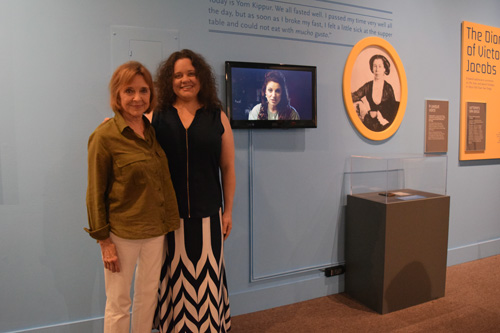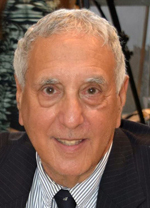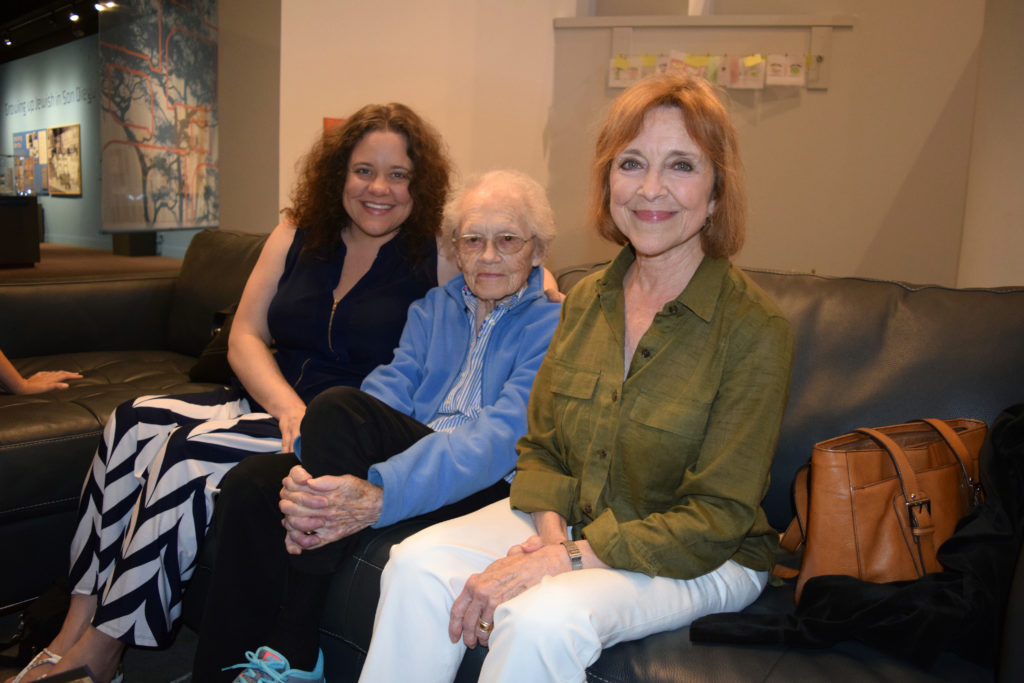
By Donald H. Harrison

SAN DIEGO — The San Diego History Center on Sunday welcomed three Arizona women whose family lent to its museum the diary of mid-19th century teenager Victoria Jacobs for the current exhibition about the history and heritage of the local Jewish community. The visitors included Alden Hardy Carroll, the great-great granddaughter of Victoria Jacobs Franklin, and Alden’s mother and grandmother, respectively Susan Hardy Aiken and Mae Hardy. Of the three, only Alden Carroll, who has a private practice counseling teenagers in Tucson, Arizona, is a direct descendant of Victoria. However, Susan, a retired English literature professor from the University of Arizona and widow of Victoria’s great-grandson, Chris Carroll, is the present owner of the diary and is knowledgeable about both the Jacobs and the Franklin families.
According to the exhibit’s written narration prepared by curator Joellyn Zollman, Victoria was born in 1838 to Marks and Hannah Jacobs in Manchester, England. The family settled in San Diego in 1851 following a stopover in Baltimore. From June 13, 1856 through Feb. 20, 1857, Victoria, then 18, kept a diary relating day-to-day events in the city that today we refer to as Old Town San Diego. On March 31, 1857, she was married to Maurice Franklin, with whom she resided briefly in San Diego at the three-story Franklin House, co-owned by his brother Lewis Franklin, before the couple moved to San Bernardino, where Victoria died in 1861. Victoria Avenue in San Bernardino subsequently was named for her.

Sitting on a comfortable couch in the exhibit’s family room — where families can read or reminisce about Jewish history in San Diego — Susan Aiken related the following information about her late husband’s family as her daughter and mother listened.
Maurice and Victoria had two sons, Abraham and Selim Maurice, who were raised after Victoria’s death by their maternal aunt, Leah Katz. Selim Maurice, born in 1859, was named for his father’s cousin Selim, who that same year was elected to the Legislature in British Columbia, the first Jew to be elected to any Legislature in British North America. The elder Selim lived to see his namesake, Selim Maurice, graduate from the law school at the University of California.
After Selim Maurice obtained his law degree, his paternal uncles, Lionel Jacobs and Barron Jacobs, lured him to Tucson, which they assured him was an up and coming city and a good place to practice law. Tuscon had been good to them: their general store had so many customers who needed to buy on credit that the Jacobs brothers divided their adobe building into two parts. In one part, the general store remained. In the other, they started a lending institution that was the first bank in Tuscon, which eventually became Pima County Bank and later tecame the First National Bank of Tucson.
Selim Maurice also thrived in Tucson, following in the footsteps of his namesake by being elected from Tucson to Arizona’s 13th Territorial Legislature, where he successfully promoted the idea of building the University of Arizona in Tucson. In the 1890s, Selim met and married Henrietta Herring, a member of an Episcopalian family. Her father, William Herring, had served as the territory’s attorney general from 1892 to 1893, and while in private practice, had been a lawyer for the notorious lawman and gunfighter of Tombstone, Arizona, Wyatt Earp.
According to Susan Aiken, Selim told Henrieta “If you will design the house of your dreams, I will build it for you” and that’s exactly what he did in the late 1890s Now on the register of National Historic Landmarks, it was a “big old ‘Victorian Territorial,’ as they called it, made of brick, and designed in Eastern fashion, very Victorian looking, with big windows,” Aiken said. “Her friends told her that this is Tucson, you don’t build big windows here; but she said ‘I love light.'” Another wing was added to the old house, so that today it occupies 5,000 square feet on a one-acre lot in Tucson’s El Presidio Historic District. The house passed into the hands of Selim’s and Henrietta’s daughter, Gladys Franklin Carroll, and after her husband John Carroll and Gladys died, Susan and Chris moved into the historic dwelling. It was where Alden was brought up.
In the large house, Susan said, they found in a temperature controlled basement, boxes and boxes of Franklin family papers scattered all over the floor. The temperature controls kept the papers safe, but considerable work had to be done to put the documents into acid-free folders for preservation purposes. Among the papers and documents was Victoria Jacobs’ tiny diary, which today is on display at the SAn Diego History Center. Because continuous light could harm the pencilled pages, the diary is exhibited closed in a special case. A local actress, who herself is a member of a well-known Jewish San Diego family, Sarah Price-Keating, granddaughter of Fedmart and Price Club founder Sol Price, dressed in period costume to read on video a selection of the diary to suggest to museum goers its flavor.
Some years ago, the late Sylvia Arden, then the archivist at the San Diego Historical Society (as the San Diego History Center previously was known) borrowed the diary from Gladys Carroll long enough to make a copy which she annotated, helping put Victoria’s short entries into context. For the most part, Victoria recounted on the diary’s pages who she saw and where she went; perhaps “trivial” to some readers, but when put into context, according to Aiken, capable of providing a treasure trove of information about a Jewish teen’s life on the mid-19th century frontier.
I asked whether anyone in Victoria’s family remained Jewish. She responded that Marjorie “Mardy” Adams, a granddaughter of Selim and Henrietta, married a Jewish man. Their daughter, Dr. Gail Stotsky, became Jewish and is bringing up her three children–Selim’s great-great grandchildren– as Jews.
Victoria’s great-great granddaughter Alden said that as a counselor in private practice who works with teeangers, she noticed a “contrast between what was important to her versus what is important to teenagers today. Now kids are plugged into the technological age, so there is a lot of contrast. Yet, in important things, they are so similar to her. She was betrothed to be married at an early age. The romantic sentiments and feelings that she had (and expressed in her diary about her dear Maurice) were similar to a lot of girls I work with who have their crushes.”
*
Harrison is editor of San Diego Jewish World as well as of the quarterly Western States Jewish History. He may be contacted via donald.harrison@sdjewishworld.com